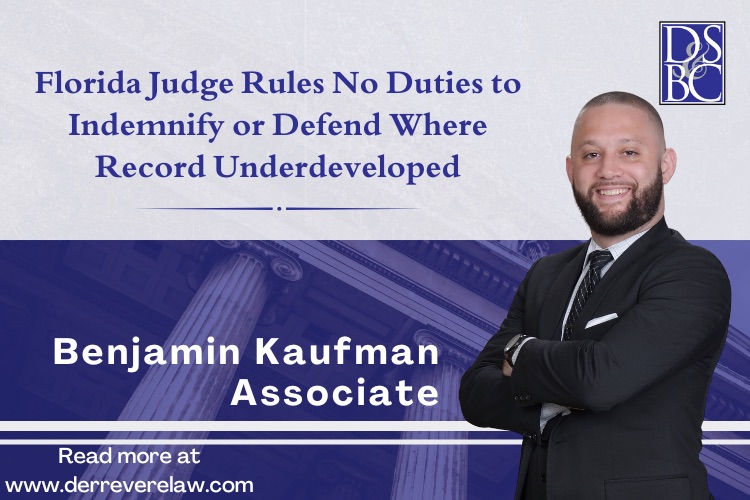A Look at Spoliation Remedies in Florida

Spoliation of evidence can make or break any case, regardless of how strong liability and damages may be. As a firm with an entire division dedicated to litigating subrogation matters, we have been on both ends of spoliation motions. This shall serve as a synopsis of how Florida handles spoliation in various scenarios.
When evidence has been destroyed, altered, or disposed of, and you are considering seeking relief due to that spoliation, the first question to ask is who the target would have been had the evidence not been spoliated. If that target is the same party who spoliated the evidence, then the relief sought would be in the form of sanctions, and not by way of a cause of action for spoliation. If instead, a third party who is not otherwise the target of your claim spoils evidence, then Florida allows for a direct cause of action for spoliation against that party.
Florida courts have discretion in granting sanctions against a party to a case who has been deemed to have spoliated evidence. The rationale is that when one party spoils evidence, it puts the other at an unfair disadvantage in being able to prosecute or defend their case. The sanctions are intended to level the playing field. The moving party in a spoliation motion must first establish entitlement to sanctions by establishing three elements: (1) the evidence existed at one time; (2) the spoliator had a duty to preserve the evidence; and (3) whether the evidence was critical to an opposing party being able to prove its prima facie case or defense. Golden Yachts Inc. v. Hall, 920 So. 2d 777 (Fla. 4th DCA 2006). A duty to preserve evidence arises from contract, agreement, statute, or administrative regulation. Martino v. Wal-Mart Stores, Inc., 835 So. 2d 1251 (Fla. 4th DCA 2003). Florida courts also recognize a duty to preserve evidence when a party should reasonably foresee litigation. League of Women Voters v. Detzner, 172 So. 3d 363 (Fla. 2015).
Once the elements for entitlement are established, the court then has discretion to impose the sanction they deem appropriate. The court can strike the pleadings and enter a default on liability as to the spoliating party. They can also enter one of two adverse jury instructions. The first is an adverse presumption jury instruction. In a normal civil matter, the Plaintiff has the burden of proof. An adverse presumption instruction shifts that burden such that the court instructs the jury they can presume the Defendant is at fault, and the Defendant then has the burden to disprove that presumption of fault. The other jury instruction that can be given is an adverse inference wherein the court instructs the jury that they may infer that the spoliating party destroyed or disposed of the evidence because it was not good for their case.
Our firm recently obtained an adverse inference jury instruction on a client’s behalf in a case that was litigated in Broward County, Florida. That case involved a multimillion-dollar home that was flooded while the homeowner and his family were away. A supply line in an upstairs bathroom disconnected and water ran continuously for days before the pest control company discovered it seeping out of the home’s exterior doors. The plumbing company who installed the plumbing components during the original construction of the property found out about the water loss and had their plumber remove the line from the property without giving the homeowners or their insurance carrier an opportunity to examine it. That supply line was lost by the plumbing company and never seen again. In a subrogation action brought by the homeowners’ insurance carrier against the plumbing company, the carrier sought relief due to the plumber’s spoliation of the supply line. The court determined the elements existed to establish the insurance carrier was entitled to a spoliation remedy, and issued a jury instruction which said the jury could, but was not required to, infer that the evidence would have been unfavorable to the plumber.
We have also defended a handful of spoliation motions. Based on our experience in handling these matters from both a proponent’s side as well as being on the defending end, there are some steps that can be taken to minimize risk with respect to potential spoliation. First, when an incident occurs, all parties involved should be instructed verbally and in writing to leave the scene or the area where the loss originated alone. Nothing should be moved, altered, or destroyed until all interested parties have an opportunity to view that scene in its original post-loss condition. Second, when evidence is already in the possession of another party, verbal and written notice should be given advising them of their duty to preserve the evidence in its original post-loss condition. Third, many times it is necessary to have an expert collect or transport the pertinent evidence and maintain a chain of custody log to ensure the evidence is not damaged. One area of evidence preservation that is not always recognized until too late is surveillance footage. Many systems automatically delete after a certain number of days. It is therefore important to take steps in preventing that automatic deletion. It is always important for parties to have evidence preservation in mind from the moment that an incident occurs. Taking these steps at the onset can place a party in a much better position for pursuing or defending spoliation relief if necessary.




